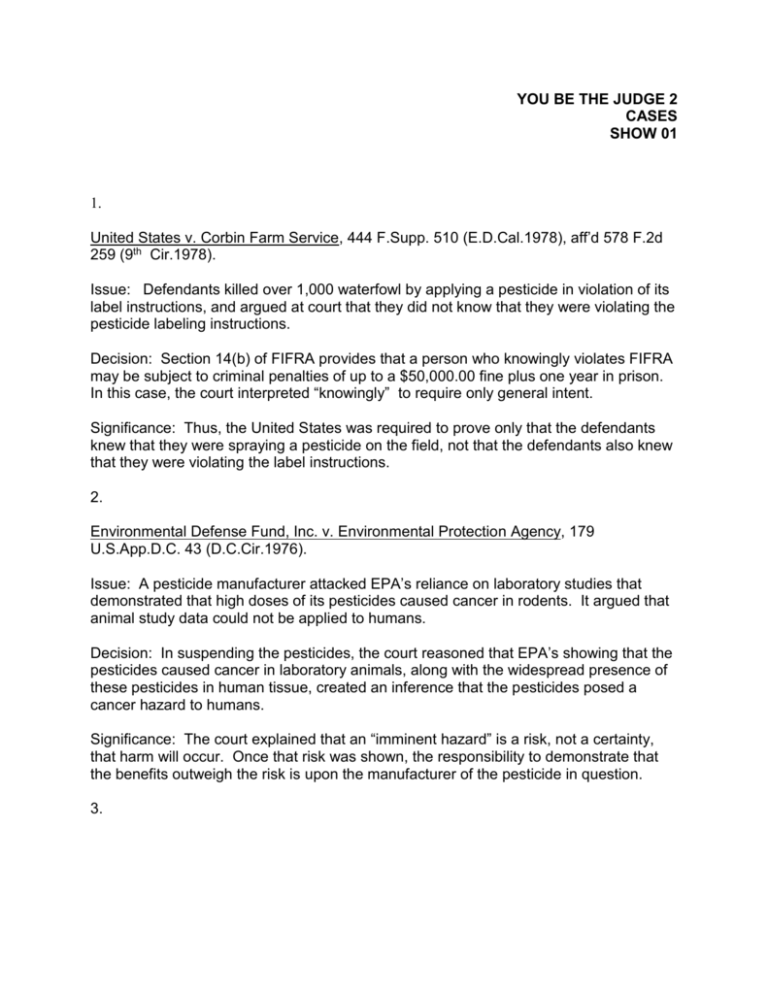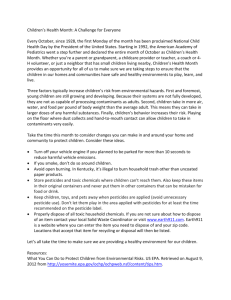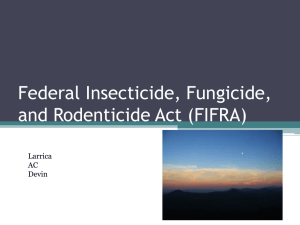Environmental Law / Pesticides
advertisement

YOU BE THE JUDGE 2 CASES SHOW 01 1. United States v. Corbin Farm Service, 444 F.Supp. 510 (E.D.Cal.1978), aff’d 578 F.2d 259 (9th Cir.1978). Issue: Defendants killed over 1,000 waterfowl by applying a pesticide in violation of its label instructions, and argued at court that they did not know that they were violating the pesticide labeling instructions. Decision: Section 14(b) of FIFRA provides that a person who knowingly violates FIFRA may be subject to criminal penalties of up to a $50,000.00 fine plus one year in prison. In this case, the court interpreted “knowingly” to require only general intent. Significance: Thus, the United States was required to prove only that the defendants knew that they were spraying a pesticide on the field, not that the defendants also knew that they were violating the label instructions. 2. Environmental Defense Fund, Inc. v. Environmental Protection Agency, 179 U.S.App.D.C. 43 (D.C.Cir.1976). Issue: A pesticide manufacturer attacked EPA’s reliance on laboratory studies that demonstrated that high doses of its pesticides caused cancer in rodents. It argued that animal study data could not be applied to humans. Decision: In suspending the pesticides, the court reasoned that EPA’s showing that the pesticides caused cancer in laboratory animals, along with the widespread presence of these pesticides in human tissue, created an inference that the pesticides posed a cancer hazard to humans. Significance: The court explained that an “imminent hazard” is a risk, not a certainty, that harm will occur. Once that risk was shown, the responsibility to demonstrate that the benefits outweigh the risk is upon the manufacturer of the pesticide in question. 3. Ethyl Corp. v. Environmental Protection Agency, 176 U.S.App.D.C. 373 (D.C.Cir.1976). Issue: Applying the Clean Air Act, which allowed regulation of substances that “endanger” the public health or welfare, the EPA ordered a reduction in the amount of lead in gasoline. Challenging the order, manufacturers of lead additives argued that this section allowed EPA to regulate only if it could prove that the lead emissions into auto exhaust caused actual harm. Decision: The court responded that endanger means something less than actual harm, stating that a statute allowing for regulation in the face of danger is a precautionary standard and that regulatory action must be taken before the threatened harm occurs. Significance: This case symbolized the new judicial willingness to protect against risk. The court explained that where a statute is designed to protect the public health, the evidence difficult to come by because scientific in nature, it would not demand rigorous step-by-step proof of cause and effect. 4. Clean Water Act Sec. 502(12) defines “toxic pollutants” as those: which after discharge and upon exposure, ingestion, inhalation or assimilation into any organism, either directly through the environment or indirectly by ingestion through food chains, will…cause death, disease, behavioral abnormalities, cancer, genetic mutations, physiological malfunctions (including malfunctions in reproduction) or physical deformations, in [any] organisms or their offspring.











